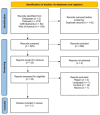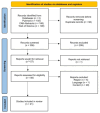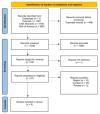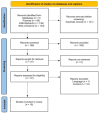Prenatal Factors Influencing Calf Morbidity and Mortality in Dairy Cattle: A Systematic Review of the Literature (2000-2024)
- PMID: 40564326
- PMCID: PMC12189275
- DOI: 10.3390/ani15121772
Prenatal Factors Influencing Calf Morbidity and Mortality in Dairy Cattle: A Systematic Review of the Literature (2000-2024)
Abstract
This study aimed to systematically review the literature of the last 24 years to determine the influence of dam heat stress, nutrition, body condition, vaccination, parity, and twin pregnancy on calf morbidity and mortality. The systematic search was carried out using PubMed, CAB Abstracts, and Web of Science databases. The final number of included studies was 11 for heat stress, 21 for nutrition, 11 for body condition, 11 for vaccination, 23 for parity, and 18 for twin pregnancy. The body condition score, parity, and twin pregnancy had an influence on perinatal mortality. Vaccination, parity, and twin pregnancy had an influence on mortality up to weaning. Heat stress, nutrition, and twin pregnancy had an influence on the immunoglobulin transfer to the calves. Nutrition, body condition score, vaccination, and parity had an influence on morbidity. This systematic review provides evidence that prenatal factors have an influence on calf morbidity and mortality.
Keywords: calf welfare; epigenetic effects; gestation.
Conflict of interest statement
The authors have not stated any conflicts of interest.
Figures












Similar articles
-
Regimens of ultrasound surveillance for twin pregnancies for improving outcomes.Cochrane Database Syst Rev. 2017 Nov 7;11(11):CD011371. doi: 10.1002/14651858.CD011371.pub2. Cochrane Database Syst Rev. 2017. PMID: 29108135 Free PMC article.
-
Amnioinfusion for chorioamnionitis.Cochrane Database Syst Rev. 2016 Aug 24;2016(8):CD011622. doi: 10.1002/14651858.CD011622.pub2. Cochrane Database Syst Rev. 2016. PMID: 27556818 Free PMC article.
-
Direct-acting antivirals for chronic hepatitis C.Cochrane Database Syst Rev. 2017 Sep 18;9(9):CD012143. doi: 10.1002/14651858.CD012143.pub3. Cochrane Database Syst Rev. 2017. PMID: 28922704 Free PMC article.
-
Acute tocolysis for uterine tachysystole or suspected fetal distress.Cochrane Database Syst Rev. 2018 Jul 4;7(7):CD009770. doi: 10.1002/14651858.CD009770.pub2. Cochrane Database Syst Rev. 2018. PMID: 29971813 Free PMC article.
-
What is the value of routinely testing full blood count, electrolytes and urea, and pulmonary function tests before elective surgery in patients with no apparent clinical indication and in subgroups of patients with common comorbidities: a systematic review of the clinical and cost-effective literature.Health Technol Assess. 2012 Dec;16(50):i-xvi, 1-159. doi: 10.3310/hta16500. Health Technol Assess. 2012. PMID: 23302507 Free PMC article.
References
-
- van der Fels-Klerx H., Saatkamp H., Verhoeff J., Dijkhuizen A. Effects of bovine respiratory disease on the productivity of dairy heifers quantified by experts. Livest. Prod. Sci. 2002;75:157–166. doi: 10.1016/S0301-6226(01)00311-6. - DOI
Publication types
Grants and funding
LinkOut - more resources
Full Text Sources

